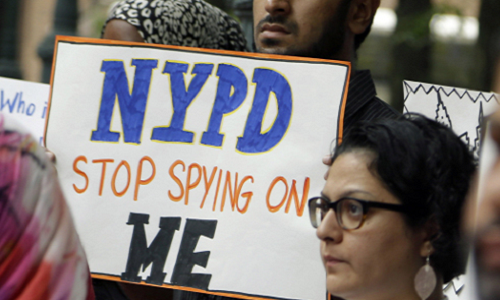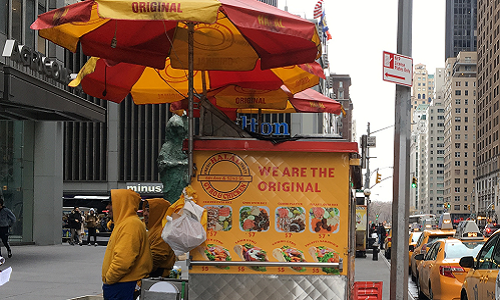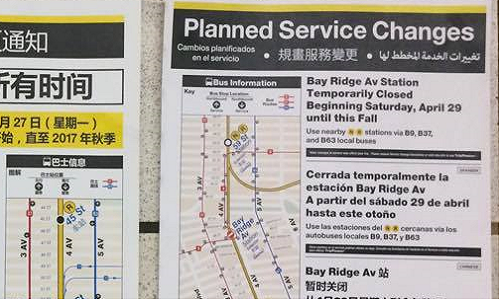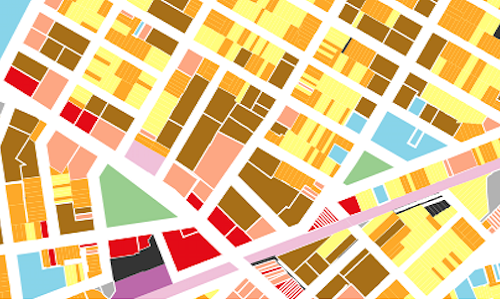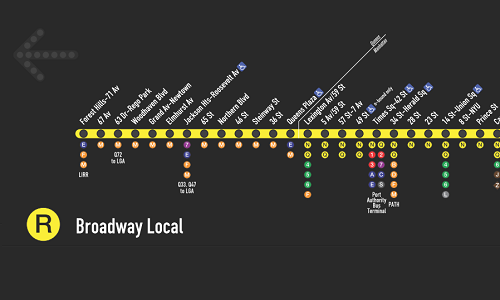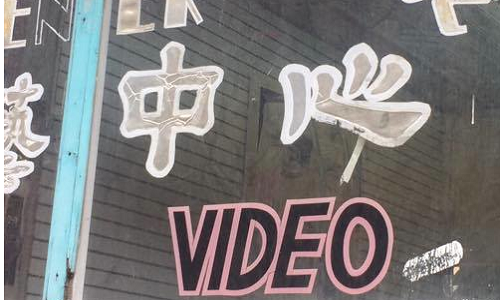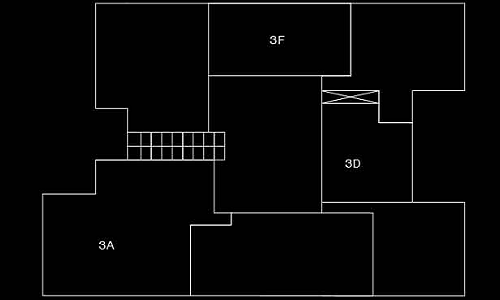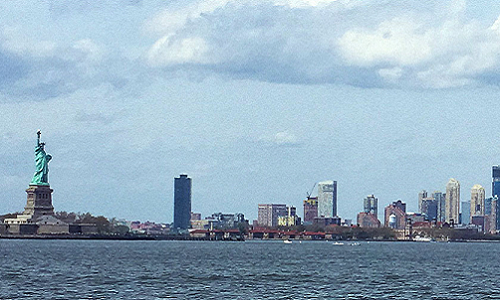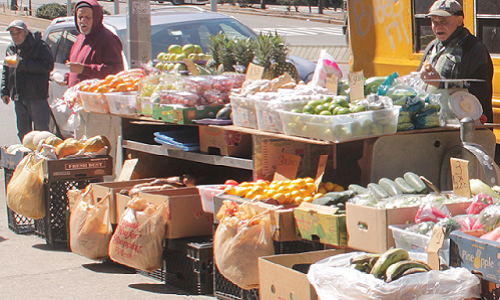Code-Switching and Police Surveillance
of Muslim Communities
This project takes the surveillance of Muslim communities connected to the Raza v. New York case between 2013 and 2016 as its focus. The project uses maps and illustrations to retell the case and reveal the ways in which the plaintiffs began a practice of “code-switching,” and adjusting their language, in the context of this surveillance.
GO TO PROJECTTranslating
Halal
Using Food Trucks as sites of language performance, this project explores the everyday multilingualism of food truck operators. On the surface, it appears that vendors only translate food, but closer examination reveals the complex linguistic negotiations that not only bridge linguistic and cultural divides, but also determine which spaces are available to whom. Through interviews with food cart vendors, we come to see how central multilingualism is to the work of the vendor, and how linguistic knowledge grants access to opportunities and spaces.
GO TO PROJECTLanguage
in Transit
The ways that languages are displayed in transit systems is a political act. This project uses New York City and Montreal’s subway systems to examine how these global cities respond to their linguistically diverse populations.
GO TO PROJECTLegitimization of Bilingual Education
in Midtown, Manhattan and Queens
Language schools are everywhere, though their status in the city is not well defined: Some are businesses, others are public institutions, and still others are informal gatherings. This projects highlights the way that the city as an institution classifies language schools by layering the location of language schools on land use maps in a residential neighborhood and business district. By aligning these two datasets, we see that there is no uniform classification for language schools, and the type of building they inhabit is heavily influenced by the neighborhood they are in.
GO TO PROJECTNavigating
Illiteracy
Navigating Illiteracy explores the particular challenges illiterate adults face when navigating public transportation in New York City, and questions what skills are implicit in reading and understanding maps, directions, and signage in a city. By exploring these themes, this project draws attention to the literacy crisis facing New York City and the United States, exposing the forces that conspire to lead to a situation of underservice for many illiterate adults.
GO TO PROJECT"Criminals with Camcorders":
The Policing of Piracy in Chinatown
This project goes on a search for the prototypical “New York City English accent”, first exploring the areas in which it was first documented by linguists (the Lower East Side and Lower Manhattan) and then taking a trip to Staten Island to find it alive and well on the busses, on the street, and in coffee shops. The author then analyzes the changing social and economic landscape of New York to help explain why the accent persists and why it may have migrated to the outer boroughs. Through this, the author connects an accent to a place, both in present and in memory, and illustrates the ways that accent helps us construct and maintain our identities.
GO TO PROJECT42-63
City Microcosm
The common idea of an ethnic enclave is a geographic area within a larger city in which a group of people live, work, shop, etc. This project turns our attention to one building, where neighbors live in separate apartments, but with a shared language and identity. Within a neighborhood, within a city, the building itself acts as an enclave, housing a community of Polish speakers, many of whom are interrelated through family and social networks. By peering into the microcosm of this building, we see how language is preserved and finds its purpose within the social networks that drew residents there.
GO TO PROJECTAccent as Index,
Accent as Benchmark
This project goes on a search for the prototypical “New York City English” accent, first exploring the areas in which it was first documented by linguists (the Lower East Side and lower Manhattan) and then taking a trip to Staten Island to find it alive and well on the busses, on the street, and in coffee shops. The author then analyzes the changing social and economic landscape of New York to help explain why the accent persist and why it may have migrated to the outer boroughs. Through this, the author connects an accent to a place, both in present and in memory, and illustrates the ways that accent helps us construct and maintain our identities.
GO TO PROJECTBoundaries and Border Crossings:
On Public Spanish in Washington Heights
Written as a first person narrative, this project maps the presence and then disappearance of Spanish from Washington Heights as the author takes us on a walk along Broadway towards the Columbia University Medical Center. While at first the languages are in tension, and their spaces clearly defined, by the end of our walking tour, we come to understand that Bilingual is, itself, a natural language, and both Spanish and English can coexist in space, community, and individual.
GO TO PROJECT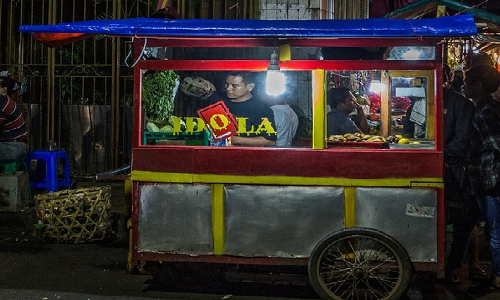
Indonesian Enclaves in New York:
Blurring Territories
Indonesians speak over 800 different languages, though multilingualism is the norm and nearly everyone also learns to speak Bahasa Indonesia, the national language. Though Indonesians are united in both language and country, conflicts have frequently arisen in Indonesia’s history. Indonesians in New York City represent this same level of diversity, with immigrants originating from nearly every part of the country. This project explores what happens when that diversity is translated into an immigrant context, and how New York based Indonesians navigate language, culture, and identity in relationship to permanent and temporary spaces.
GO TO PROJECTFaculty
| Name | Title | |
|---|---|---|
| Laura Kurgan | Director, Center for Spatial Research, Associate Professor, Graduate School of Architecture, Planning and Preservation | ljk33@columbia.edu |
| Lydia Liu | Wun Tsun Tam Professor in the Humanities, Director, Institute for Comparative Literature and Society | ll2410@columbia.edu |
| Michelle McSweeney | Mellon Associate Research Scholar, Center for Spatial Research | mam2518@columbia.edu |
| Yasmeen Abdel Majeed | Research Assistant, Columbia College '18 | ya2332@columbia.edu |
| Rachel Fifi-Culp | Research Assistant, Columbia College '17 | rgf2117@columbia.edu |
Students
| Name | School | Program |
|---|---|---|
| A.L. Hu | Graduate School of Architecture, Planning and Preservation | Master of Architecture |
| Abubakr Hayder Ali | Graduate School of Architecture, Planning and Preservation | Master of Science in Advanced Architectural Design |
| Alex Curtis | Columbia College | Bachelor of Arts in Philosophy |
| Andrew Pasquier | Columbia College | Bachelor of Arts in Political Science and Urban Studies |
| Anish Gawande | Columbia College | Bachelor of Arts in Comparative Literature and Society |
| Anne-Laura White | Columbia College | Bachelor of Arts in American Studies |
| Daniel Cooper | Graduate School of Architecture, Planning and Preservation | Masters of Science in Critical, Curatorial, and Conceptual Practices in Architecture |
| Dissa Pidanti Ramas | Graduate School of Architecture, Planning and Preservation | Master of Science in Architecture and Urban Design |
| Kurt Streich | Graduate School of Architecture, Planning and Preservation | Master of Architecture |
| Laura Blaszczak | Barnard College | Bachelor of Arts in Architecture |
| Laura Cadena | Columbia College | Bachelor of Arts in Anthropology |
| Madeleine McGrory | Graduate School of Architecture, Planning and Preservation | Master of Science Urban Planning |
| Marwah Garib | Graduate School of Architecture, Planning and Preservation | Master of Science Urban Design |
| Matthew Ransom | Graduate School of Architecture, Planning and Preservation | Master of Architecture |
| Mayssa Jallad | Graduate School of Architecture, Planning and Preservation | Master of Science in Historical Preservation |
| Rachel Fifi-Culp | Columbia College | Bachelor of Arts in Urban Studies and Sustainable Development |
| Shuman Wu | Graduate School of Arts and Science | Master of Science in Architecture and Urban Design |
| Valerie Lechene | Graduate School of Architecture, Planning and Preservation | Master of Architecture |
| Viviana Prado-Nunez | Columbia College | Bachelor of Arts in Creative Writing |
| Yasmeen Abdel Majeed | Columbia College | Bachelor of Arts in History |
